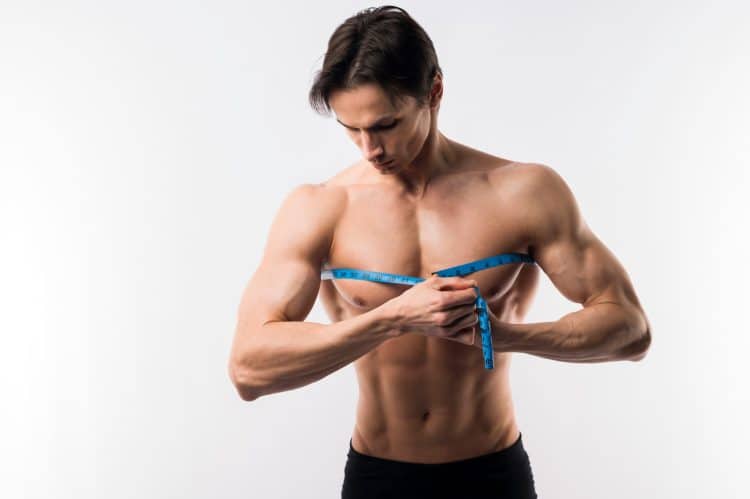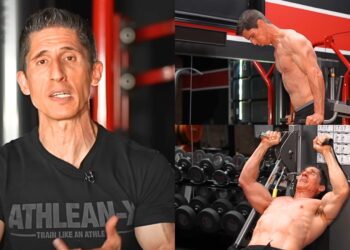Chest size for men plays a huge role in their physique aesthetics. A broad chest can accentuate your V-taper and create an aura of grandeur around you. It’s no surprise Hollywood uses men (and even cartoon characters) with wide chests to portray imposing men like generals, superheroes, or even a rich man that comes out of his cave in the dead of the night wearing a cape when a distress signal is flashed. We’re talking about Batman, in case it wasn’t clear.
Although people usually talk about a broad and full chest, hardly anyone puts a number to it. Trainers and experienced lifters keep hammering the point that you need a wide chest, but it is seldom that anyone tells you what the measuring tape should read when wrapped around your pecs.
In this article, we take the guesswork out of the equation and lay out the average chest size for men and three ways of measuring your chest.
Average Chest Size for Men
What is the average male chest size? While this question might sound trivial, the truth is the data we have on this is scarce. In fact, it is so limited that for the first time since World War II, it was only in 2004 that a national survey sized up the average American body, not just by weight and height or even the standard chest-waist-hip routine, but in more than 240 measurements.

The survey was called SizeUSA and it was sponsored by clothing and textile companies, the Army, the Navy, and several universities. They measured more than 10,000 people in 13 cities nationwide using a light-pulsing 3-D scanner.
According to the survey, the average American man has changed significantly in the last sixty years. When it comes to chest circumference, most men are larger than the traditional 40 regular, which was long considered the average. A 40 regular, according to standards, means a 40-inch chest, 34-inch waist, and 40-inch hip, with a 15.5-inch collar.
Level Up Your Fitness: Join our 💪 strong community in Fitness Volt Newsletter. Get daily inspiration, expert-backed workouts, nutrition tips, the latest in strength sports, and the support you need to reach your goals. Subscribe for free!
According to the survey, the average chest size of an American man is 42 inches (107 cm).
In the survey, white men ages 18 to 25 had, on average, a 41-inch chest. From ages 36 to 45, caucasian men came in at 44 inches, black men at 43 inches, Hispanic men at 44 inches, and ”other” at 42 inches.
Notably, the researchers weighted their samples according to a Centers for Disease Control and Prevention study of average height and weight to ensure they did not count too many people who were especially heavy or light, short or tall. [1]
Trivia: The last national survey was conducted in 1941 when the United States Department of Agriculture sent out researchers with tape measures to size up the population in anticipation of designing military uniforms for World War II.
Interestingly, in 2004, the average chest size for men had spiked two inches from the 40-inch average found in the 1941 U.S. Department of Agriculture study.
Where do you fall?
Since there is no other reliable data or recent sizing surveys, you should use the finding from the 2004 study to check how you stack against the average American.
If you are a white male in the 18 to 25 age range, a chest size below 41 inches can be considered small, and anything above 41 can be deemed large. However, a couple of inches—either way—shouldn’t be a cause for concern.
Furthermore, the average male chest size can vary depending on where a person lives, his society, and his job type [2].
Average Chest Size For Boys
The average chest size of a boy increases as he ages. Here are the chest sizes of boys of different ages:
| Age | Chest Size (in inches) |
| 2 | 20.1 inches |
| 3 | 20.5 inches |
| 4 | 21.8 inches |
| 5 | 22.2 inches |
| 6 | 23.3 inches |
| 7 | 23.8 inches |
As you can see, the average size of a healthy boy’s chest grows gradually and keeps getting bigger until well into adulthood.
Check Out: What is a Good Height for Bodybuilding?
How To Measure Your Chest Size
Besides giving you the tools to stack yourself against your peers and assessing your muscle building or weight loss progress, knowing your chest size can save you tremendous time while shopping for new clothes.
Level Up Your Fitness: Join our 💪 strong community in Fitness Volt Newsletter. Get daily inspiration, expert-backed workouts, nutrition tips, the latest in strength sports, and the support you need to reach your goals. Subscribe for free!
While you could take your own chest measurement, we recommend getting assistance as it can help get a more accurate reading.
If you get two people to measure your chest, both might give you different numbers. Wrapping the tape too high, low, or diagonally can skew your results. Also, use a flexible measuring tape for a more accurate chest circumference reading.
Here is how to measure your chest size correctly:
- For an exact measurement, take off your shirt and stand with your arms held loosely out from your body. Do not flex as it might alter your measurements.
- Ask someone to wrap the tape measure around the thickest part of your chest. Typically, this puts the flexible measure tape on your nipple line or just under your armpits.
- Make sure the tape measure is parallel to the floor around the back and front of your chest.
- Note down the number where the tape overlaps. This will be your chest size.
- Take two to three measurements for a more accurate assessment.
How To Measure Your Chest Width (Half-Chest Method)
Although many people confuse the two, chest circumference and width are two different measurements. While chest width refers to the horizontal distance between your armpits, chest size usually refers to chest circumference.
There are two ways of taking your chest width measurement. The first involves measuring the width of your chest, while the other requires you to measure the width of a piece of clothing that fits you well. It goes without saying the former is more accurate than the latter.
1. Body Measurement
How to take a half-chest measurement on your body:
- Take off your shirt and stand with your arms held out loosely.
- Ask someone to measure your chest width by measuring between the skinfold of each armpit—the points where your upper arms meet your chest. This will be your chest size.
You could also take your own measurement in this method by measuring between the skinfold of each armpit. However, the assisted method is much more reliable.
2. Garment Measurement
How to take a half-chest measurement using a piece of garment:
- Get a shirt or t-shirt that fits you well.
- Spread the garment on a flat surface like a table or rug.
- Align a tape measure to stretch from one side seam to the other side seam just below the sleeve.
- The number you get will be your chest size as per this method.
Tip: If you know your chest width, you could determine your chest circumference by multiplying the chest width by two.
Most brands use the half-chest measurement method on their online size charts. While buying from your favorite brand, measure the width of your favorite shirt and order accordingly. Your new garment should fit you perfectly.
How To Measure Your Chest Size Without a Measuring Tape
We are entering the pro territory with this section. Even a rookie could check their chest size using a measuring tape. However, who wants to come off as a rookie in a testosterone-filled men’s gym locker room?
Here is how to find your chest size using a piece of string:
- Find a piece of string long enough to wrap around your torso.
- Use the string just like you would use a flexible tape measure and wrap it around the fullest part of your chest.
- Use a sharpie to mark the points where the string overlaps.
- Place the string on the t-shirt you wore to the gym.
- You’ll get a rough idea of your chest size by stacking the string against the t-shirt size.
Let’s say you don’t want to show off your chest-size reading skills but do not have access to a flexible measuring tape. There is an easier and more accurate way of determining your exact chest size while using a piece of string. This is how to do it:
- Follow the first three steps mentioned above.
- Spread the string on a flat surface.
- Use a ruler or metal tape to measure the marked length.
FAQs
What is a good chest size for bodybuilding?
Bodybuilding shows are judged based on muscle mass, symmetry, balance, and conditioning. The chest size doesn’t play a big role in isolation. However, bodybuilders should ideally have a bigger chest size than the average American male, meaning if you’re an aspiring bodybuilder, you should target a number north of 42 inches.
Must Read: Understanding How Men’s Open Bodybuilding Competitions are Judged and Scored
What is a normal chest size for a male?
A two-inch fluctuation on either side of the average chest size can be considered normal. So if you are an adult American male and your chest size ranges between 40-44 inches, your pec size is normal.
How to increase your chest size?
For building pectoral muscle mass, you need to hit the trifecta. Your diet, training, and recovery program should complement one another.
Related: The 9 Best Chest Exercises According to Science
You might also like:
- The Average Calf Size for Men and Women
- Average Biceps Size: How Do You Measure Up?
- Average Waist Size For Women and Men
Wrapping Up
Knowing your chest size and how to measure it correctly can help you track your fitness progress and enable better decision-making while shopping for clothes. Furthermore, knowing the average male chest size helps you stack yourself against your peers.
References
- Fryar CD, Kruszon-Moran D, Gu Q, Carroll M, Ogden CL. Mean body weight, height, waist circumference, and body mass index among children and adolescents: United States, 1999–2018. National Health Statistics Reports; no 160. Hyattsville, MD: National Center for Health Statistics. 2021. DOI: https://dx.doi.org/10.15620/cdc:107559.
- Kryst, Ł, Woronkowicz, A, Kowal, M, Sobiecki, J. Intergenerational changes in chest size and proportions in children and adolescents aged 3–18 from Kraków (Poland), within the last 70 years. Am J Hum Biol. 2017; 29:e22918. https://doi.org/10.1002/ajhb.22918









